Oishinbo by Tetsu Kariya (writer) & Akira Hanasaki (artist)
(Pages read from left to right)
A very serious discussion awaits HU readers next week, so I’ve decided to dwell on one of the more simple-minded manga series published in the last few years — the info-food manga, Oishinbo. The sole purpose of this manga mutate is to entertain while conveying information. So not exactly the equivalent of Jeremy Issac’s The World at War, but certainly a distant cousin of Anthony Bourdain eating a warthog anus.
The creators of Oishinbo are the “good” kind of fascist — food fascists. That breed of benevolent despot who shakes his fist at supermarkets which display their sake out of their cases and under harsh fluorescent lights; that friend who slaps her children’s hands if they use their chopsticks incorrectly; or the sniffy office mate who raises his eyebrows when he discovers that you’ve taken your steak well done. This kind of tyranny is catching, and ever since reading the volume titled, “Sake”, I’ve stopped buying that strain of salacious sake which doesn’t come under wraps. Of course, as with all good fascists, the food fascist is best observed at a distance, the better to preserve our sanity (and also to giggle). Which makes this manga an ideal instrument for such encounters.
Why anyone would want to dwell on the underlying plot of Oishinbo is beyond me, so I won’t. Let’s start with the champagne instead.
The authors of Oishinbo are only interested in the best. This means otoro when it comes to tuna, and it means Dom Pérignon and Krug when it comes to champagne. It’s a reasonable choice. As champagne goes, Dom Pérignon and Krug are pretty tasty.
In this episode, the hero is trying to initiate a company man into the romance of champagne, a drink which that unbeliever has developed an acute phobia towards in view of a prior drunken episode (he opened 3 bottles but we’re never told how much he actually drank).
All the basic information on that gassy beverage is neatly laid out: the myth of the monk; flutes > saucer-shaped glasses etc. That’s when the French boosterism starts: the pooh-poohing of sparkling wines; and the reverent tones as the mysteries of the “traditional method” (remuage, degorgement, what have you) are laid bare. Most amusing and edifying of all is this statement:
“…of all drinks, champagne is the least likely to get you drunk and give you a hangover.”
In other words, this is licence to drink a couple of bottles of Krug or Dom P. without fear of getting pissed. Begone inferior Japanese copycats!
Anyways, a far cry indeed from the demystification Jancis Robinson opts for in her Wine Course TV series. I particularly enjoyed the bemused tone as Robinson describes the process of remuage with her hands moving in opposite directions as if rotating a pair of breasts. Then there’s the gentle ribbing of Richard Geoffroy (Chef de Cave at Dom Pérignon) when he describes champagne sediment with dulcet tones of awe (“Looks rather horrid to me,” she smirks. “Some respect please,” he admonishes). That’s the kind of levity you can afford when you’re a Master of Wine I suppose.
So Kariya and Hanasaki: not so good with the champagne but better with the sake. What about the salmon, you ask?
Now some of you might think that salmon is a rather pricey fish when sensitively smoked or turned into gravad lax. But in sashimi circles, salmon is the fish of plebs; undoubtedly one of the most common fish types you will find on your sashimi platter in Asia. This is the fish they serve you if you don’t have any money. And look at the fury on this man’s face once he discovers that his son has ingeniously decided to serve raw fresh salmon fillet on a bed of chrysanthemum petals as part of a food challenge.
[“I cannot accept this dish! It’s a failure!”]
Now some of you will be thinking that the man (a food connoisseur) has a problem with chrysanthemums (maybe he prefers carnations?). But it’s much simpler than that. You see, raw salmon is poison! It will turn you into a shivering wreck and make you look like Maria Callas on tapeworms.
Consider exhibit A:
[Look on my works, ye Mighty, and despair!]
Look at the face of this man.
Just two pages before this, the hero killed his dog and served it to him raw.
Well, not quite, but close enough. Dispensers of raw salmon (a sizable part of the human race I should add) are indubitably the progenitors of an incipient world wide food cataclysm. After Oishinbo, you will never look at that meaty pink fish at your local restaurant the same again.
It doesn’t end there of course. I have neither the time nor energy to touch on the ramen cabals (more strict than Tsutomu Yamazaki in the movie Tampopo) and the gyoza fast food outlets with more flavors than a Baskin-Robbins.
For the initiated, gyoza (or jiaozhi as it’s pronounced in Chinese) is a fried dumpling which has its origins in China. You can find them at your local Shanghainese or Szechuan restaurant and, yes, your ramen outlet as well. Now, I can understand why the Japanese invented machines to dispense soiled women’s panties, but the idea of frequenting an outlet so that you can stuff yourself with endless amounts of fried flour wrapped around meat, and in 100 flavors? What kind of glutton would even want to eat at such a place?
Well, Oishinbo tells you this and more. I enjoyed every minute of it, you will too.

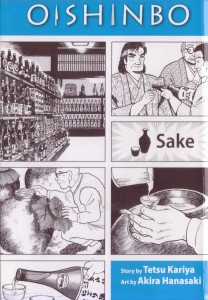
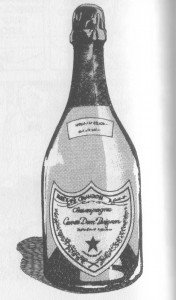
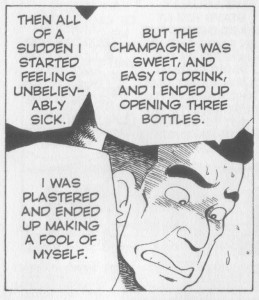
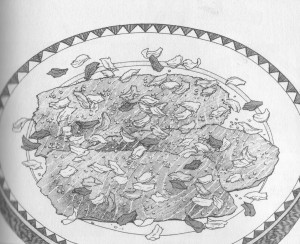
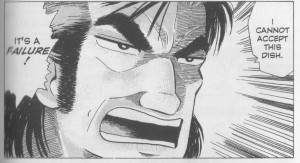
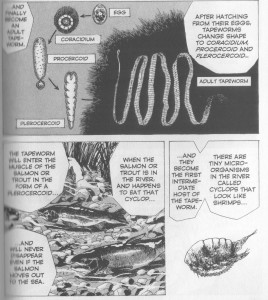
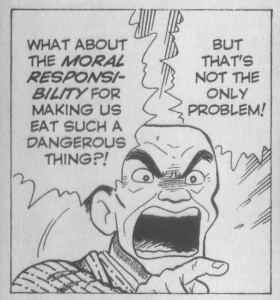
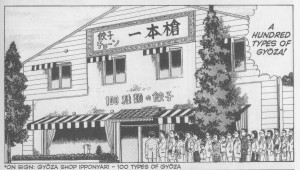
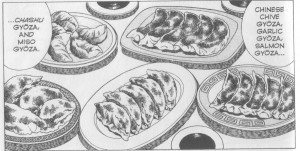
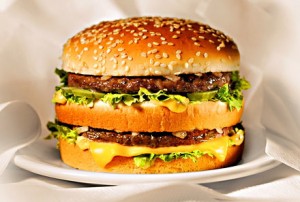
“A very serious discussion awaits HU readers next week”
We’re having a roundtable on Shoah.
“…of all drinks, champagne is the least likely to get you drunk and give you a hangover.”
If you are buying $150 bottles, I bet that’s true! Or at least, you can maybe only afford one hangover every two months.
Just two pages before this, the hero killed his dog and served it to him raw.
I hope that’s an exaggeration.
I wonder whether wine stores sell out of the brands mentioned in Oishinobu the way they do with the brands (or years) mentioned in Drops of God: http://www.nytimes.com/2008/10/22/world/asia/22iht-comic.1.17160430.html
My God, champagne can give one of the worst hangovers you care never to experience.
I found this out to my cost, in the aftermath of a champagne and strawberries breakfast I partook of on the quad of Trinity College in Cambridge, back in April 1976.
Alex: Maybe it was actually sparkling wine they gave you….Anyway, yes, the bubbles are supposed to increase the rate of absorption right? Or is that apocryphal? I’ve definitely met people who have had terrible hangovers after a champagne party. And there are sparkling wines made in France which taste as good as some champagnes I think.
Subdee: “I hope that’s an exaggeration.”
Actually, he’s complaining about being given fresh raw salmon to eat. But he sure looks like he just ate his dog raw.
And, yep, the first thing that occurred to me on reading that story was what kind of person would consider drinking 3 bottles of Dom Perignon at one sitting.
There was a Korean drama called, “Terroir”, sometime back. It opens with a scheme to get a rare “first growth”. Could have been a Margaux but I vaguely remember some fake labels being supplied. Think it was a ratings failure, hence no increase in wine sales…
And why the snubbing of Veuve Cliquot? Hmm? No, no, this will not do.
Apparently they found out that Australian Duty Free was selling specially packaged Veuve (2 to a carton) at much reduced prices. Food fascists are snobs by definition.
I read somewhere about a very popular manga centered on wine, and it was all about a quest to corner the market on the finest wine in France. Thing is, the strip featured a real tiny French vinyard, whose modest owner was startled to find out he was superstar in Japan!
Could be a tribute to Henri Jayer…?
Let me google that…
By God, Suat, you are right. You frighten me sometimes:
http://en.wikipedia.org/wiki/Les_Gouttes_de_Dieu
Ha, ha! It is the same popular wine manga I linked earlier. The brother and/or sister who write Drops of God have written sooooooo many other popular manga: Kindaichi Case Files, Psychometrer Eiji, Getbackers…
Drops of God is coming soon from Vertical in English.
The bubbles in sparkling beverages do indeed accelerate drunkenness. Sparkling wines, especially champagne can give devastating hangovers because of the very high sugar content necessary for bottle-fermentation.
Also I, I want to eat 100 flavors of Gyoza. Give me 100 of each, please.
They are goddam right about salmon sushi.
Nearly all salmon for sushi is farm-bred;the salmon from pisciculture, because of artificial overcrowding of the fish, is far, far more susceptible to parasite infestation.
This isn’t a problem when the flesh is cooked or smoked or otherwise treated;but, raw in sushi or sashimi? gastronomic Russian roulette.
I saw a programme on TV yesterday: there are almost as many sushi bars (about 1600) in France as there are fast-food joints à la McDonald’s (about 1700). How are these sushi bars to maintain quality control at that level?
Pingback: Now we are six! « MangaBlog
And what is the primary fish in all those French sushi bars? Salmon? Why aren’t there more people in France with liver flukes and tapeworms?
They probably freeze the fish to kill parasites. As I understand it, all U.S. sushi must be frozen before serving; I expect the EU has similar regulations. Still, 1600 sushi bars is an awful lot of bad sushi. There’s just not enough fish!
That said, I had an unbelievable salmon belly sashimi in a little bar in Shirahama. Caught that day, probably one of the five best things I’ve ever eaten, but I’m kind of a pleb.
Most people in the world are…
And the manga does recommend freezing salmon before eating, which sort of makes all the promises of “fresh” salmon slightly untruthful I suppose (since most of it is frozen for 1-2 weeks or flash-frozen).